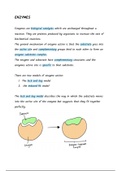Summary
Summary Enzymes
- Course
- Institution
This summary includes the models of enzyme action, the factors affecting the rate of enzyme reactions including examples of rate graphs as you will see in exam questions related to this topic, descriptions of the different types of inhibition and cofactors. Suitable for all A-level biology exam boa...
[Show more]




